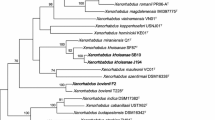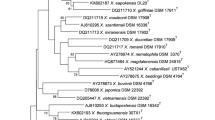Abstract
The bacterial species of the genus Xenorhabdus in the family Enterobacteriaceae have a mutualistic association with steinernematid entomopathogenic nematodes (EPNs), which have been used as biological control agents against soil insect pests. In this study we present the genetic and phenotypic characterizations of the Xenorhabdus species isolated from steinernematid nematodes in Japan. The 18 Japanese Xenorhabdus isolates were classified into five bacterial species based on 16S ribosomal RNA (16S rRNA) gene sequences: Xenorhabdus bovienii, Xenorhabdus hominickii, Xenorhabdus indica, Xenorhabdus ishibashii, and Xenorhabdus japonica. There was no genetic variation between the 16S RNA sequences among the three X. ishibashii isolates, 0–0.1% variation among the five X. hominickii isolates, and 0–0.5% among the eight X. bovienii isolates. Phenotypic characterization demonstrated that representative isolates of the five bacterial species shared common characteristics of the genus Xenorhabdus, and only X. hominickii isolates produced indole. Symbiotic association and co-speciation of Xenorhabdus bacteria with Steinernema nematodes from Japan are discussed.


Similar content being viewed by others
References
Akhurst RJ (1980) Morphological and functional dimorphism in Xenorhabdus spp., bacteria symbiotically associated with the insect pathogenic nematodes Neoaplectana and Heterorhabditis. J Gen Microbiol 121:303–309
Akhurst RJ (1983) Taxonomic study of Xenorhabdus, a genus of bacteria symbiotically associated with insect pathogenic nematodes. Int J Syst Bacteriol 33:38–45
Akhurst RJ (1986) Xenorhabdus nematophilus subsp. poinarii: its interaction with insect pathogenic nematodes. Syst Appl Microbiol 8:142–147
Akhurst RJ, Boemare NE (1988) A numerical taxonomic study of the genus Xenorhabdus (Enterobacteriaceae) and proposed elevation of the subspecies of X. nematophilus to species. J Gen Microbiol 134:1835–1845
Bedding RA, Akhurst RJ (1975) A simple technique for the detection of insect pathogenic nematodes in soil. Nematologica 21:109–110
Boemare NE (2002) Biology, taxonomy and systematics of Photorhabdus and Xenorhabdus. In: Gaugler R (ed) Entomopathogenic nematology. CABI, Wallingford, pp 35–56
Darriba D, Taboada GL, Doallo R, Posada D (2012) jModelTest 2: more models, new heuristics and parallel computing. Nat Methods 9:772
Dowds BCA, Peters A (2002) Virulence mechanisms. In: Gaugler R (ed) Entomopathogenic nematology. CABI, Wallingford, pp 79–98
Ehlers R-U (2005) Forum on safety and regulation. In: Grewal PS, Ehlers R-U, Shapiro-Ilan DI (eds) Nematodes as biocontrol agents. CABI, Wallingford, pp 107–114
Elawad S, Ahmad W, Reid A (1997) Steinernema abbasi sp. n. (Nematoda: Steinernematidae) from the Sultanate of Oman. Fundam Appl Nematol 20:433–442
Ferreira T, van Reenen CA, Endo A, Spröer C, Malan AP, Dicks LM (2013) Description of Xenorhabdus khoisanae sp. nov., the symbiont of the entomopathogenic nematode Steinernema khoisanae. Int J Syst Evol Microbiol 63:3220–3224
Ferreira T, van Reenen CA, Tailliez P, Pagès S, Malan AP, Dicks LM (2016) First report of the symbiotic bacterium Xenorhabdus indica associated with the entomopathogenic nematode Steinernema yirgalemense. J Helminthol 90:108–112
Fischer-Le Saux M, Mauléon H, Constant P, Brunel B, Boremare NE (1998) PCR-ribotyping of Xenorhabdus and Photorhabdus isolates from the Caribbean region in relation to the taxonomy and geographic distribution of their nematode hosts. Appl Environ Microbiol 64:4246–4254
Fischer-Le Saux M, Viallard V, Brunel B, Normand P, Boemare NE (1999) Polyphasic classification of the genus Photorhabdus and proposal of new taxa: P. luminescens subsp. luminescens subsp. nov., P. luminescens subsp. akhurstii subsp. nov., P. luminescens subsp. laumondii subsp. nov., P. temperata sp. nov., P. temperata subsp. temperata subsp. nov. and P. asymbiotica sp. nov. Int J Syst Evol Microbiol 49:1645–1656
Forst S, Clarke D (2002) Bacteria-nematode symbiosis. In: Gaugler R (ed) Entomopathogenic nematology. CABI, Wallingford, pp 57–77
Guindon S, Dufayard JF, Lefort V, Anisimova M, Hordijk W, Gascuel O (2010) New algorithms and methods to estimate maximum-likelihood phylogenies: assessing the performance of PhyML 3.0. Syst Biol 59:307–321
Jukes TH, Cantor CR (1969) Evolution of protein molecules. In: Munro HN (ed) Mammalian protein metabolism. Academic Press, New York, pp 21–132
Kaya HK, Stock SP (1996) Techniques in insect nematology. In: Lacey L (ed) Manual of techniques in insect pathology. Academic Press, San Diego, pp 281–322
Kuwata R, Shigematsu M, Yoshiga T, Yoshida M, Kondo E (2006a) Intraspecific variations and phylogenetic relationships of steinernematids isolated from Japan based on the sequences of the ITS region of the nuclear rRNA gene and the partial mitochondrial COI gene. Jpn J Nematol 36:11–21
Kuwata R, Shigematsu M, Yoshiga T, Yoshida M, Kondo E (2006b) Phylogenetic analyses of Japanese steinernematid nematodes and their associating Xenorhabdus bacteria. Jpn J Nematol 36:75–85
Kuwata R, Qiu LH, Wang W, Harada Y, Yoshida M, Kondo E, Yoshiga T (2013) Xenorhabdus ishibashii sp. nov., isolated from the entomopathogenic nematode Steinernema aciari. Int J Syst Evol Microbiol 63:1690–1695
Larkin MA, Blackshields G, Brown NP, Chenna R, McGettigan PA, McWilliam H, Valentin F, Wallace I, Wilm MA, Lopez R, Thompson JD, Gibson TJ, Higgins DG (2007) Clustal W and Clustal X version 2.0. Bioinformatics 23:2947–2948
Lengyel K, Lang E, Fodor A, Szállás E, Schumann P, Stackebrandt E (2005) Description of four novel species of Xenorhabdus, family Enterobacteriaceae: Xenorhabdus budapestensis sp. nov., Xenorhabds ehlersii sp. nov. Xenorhabdus innexi sp. nov., and Xenorhabdus szentirmaii sp. nov. Syst Appl Microbiol 28:115–122
Long SJ, Richardson PN, Fenlon JS (2000) Influence of temperature on the infectivity of entomopathogenic nematodes (Steinernema and Heterorhabditis spp.) to larvae and pupae of the vine weevil Otiorhynchus sulcatus (Coleoptera: Curculionidae). Nematology 2:309–317
Nishimura Y, Hagiwara A, Suzuki T, Yamanaka S (1994) Xenorhabdus japonicus sp. nov. associated with the nematode Steinernema kushidai. World J Microbiol Biotechnol 10:207–210
Page RDM (2001) TreeView version 1.6.6. University of Glasgow, Glasgow. http://taxonomy.zoology.gla.ac.uk/rod/treeview.html. Accessed 9 Nov 2016
Phan LK, Takemoto S, Futai K (2006) Steinernema ashiuense sp. n. (Nematoda: Steinernematidae), a new entomopathogenic nematode from Japan. Nematology 8:681–690
Poinar GO Jr, Thomas GM (1965) A new bacterium, Achromobacter nematophilus sp. nov. (Achromobacteriaceae: Eubacteriales) associated with a nematode. Int J Bull Bacteriol Nomencl Taxon 15:249–252
Somvanshi VS, Lang E, Ganguly S, Swiderski J, Saxena AK, Stackebrandt E (2006) A novel species of Xenorhabdus, family Enterobacteriaceae: Xenorhabdus indica sp. nov., symbiotically associated with entomopathogenic nematode Steinernema thermophilum Ganguly and Singh. Syst Appl Microbiol 29:519–525
Tailliez P, Pagés S, Ginibre N, Boemare NE (2006) New insight into diversity in the genus Xenorhabdus, including the description of ten novel species. Int J Syst Evol Microbiol 56:2805–2818
Tailliez P, Pagès S, Edgington S, Tymo LM, Buddie AG (2012) Description of Xenorhabdus magdalenensis sp. nov., the symbiotic bacterium associated with Steinernema australe. Int J Syst Evol Microbiol 62:1761–1765
Thomas GM, Poinar GO Jr (1979) Xenorhabdus gen. nov., a genus of entomopathogenic nematophilic bacteria of the family Enterobacteriaceae. Int J Syst Bacteriol 29:352–360
Tsai MH, Tang LC, Hou RF (2008) The bacterium associated with the entomopathogenic nematode Steinernema abbasi (Nematoda: Steinernematidae) isolated from Taiwan. J Invertebr Pathol 99:242–245
Yoshida M (2003a) Intraspecific variation in RFLP patterns and morphological studies on Steinernema feltiae and S. kraussei (Rhabditida: Steinernematidae) from Hokkaido, Japan. Nematology 5:735–746
Yoshida M (2003b) Identification of entomopathogenic nematodes in Japan. Plant Protect 57:237–242 (in Japanese)
Yoshida M (2004) Steinernema litorale n. sp. (Rhabditida: Steinernematidae), a new entomopathogenic nematode from Japan. Nematology 6:819–838
Yoshida M (2007) A new distribution record of Steinernema abbasi Elawad, Ahmad and Reid, 1997 (Rhabditida: Steinernematidae) in Japan with a note on its pathogenicity against the turnip moth larvae, Agrotis segetum (Lepidoptera: Noctuidae). Jpn J Nematol 37:51–61
Yoshida M (2010) Influence of temperature on pathogenicity of some entomopathogenic nematode isolates (Steinernema spp.) from Japan screened for ability to control some noctuid moth larvae. Nematol Res 40:27–40
Yoshida M, Alexander PR, Bernard RB, William MH (1998) Survey of entomopathogenic nematodes (Rhabditida: Steinernematidae and Heterorhabditidae) in Japan. Fundam Appl Nematol 21:185–198
Acknowledgments
The authors would like to thank Dr Nobuo Ogura of the Department of Agriculture, Meiji University for providing Steinernema kushidai strain Hamakita. We also thank Dr Takayuki Mizukubo of the National Agricultural Research Center for his helpful support. This work was supported in part by Grants-in-Aid (nos. 14760030, 17780042) from the Ministry of Education, Culture, Sports Science, and Technology of Japan, and by Grants for the Development of New Biorational Techniques for Sustainable Agriculture (J040600014, J050400018).
Author information
Authors and Affiliations
Corresponding author
Additional information
The DNA Data Bank of Japan accession numbers for the 16S ribosomal RNA gene are: AB507811-AB507818.
Rights and permissions
About this article
Cite this article
Kuwata, R., Yoshida, M. & Yoshiga, T. Genetic and phenotypic characterizations of Xenorhabdus species (Enterobacteriales: Enterobacteriaceae) isolated from steinernematid nematodes (Rhabditida: Steinernematidae) in Japan. Appl Entomol Zool 52, 125–134 (2017). https://doi.org/10.1007/s13355-016-0463-y
Received:
Accepted:
Published:
Issue Date:
DOI: https://doi.org/10.1007/s13355-016-0463-y




